LEGO: A Strategic Analysis
Posted by Huw,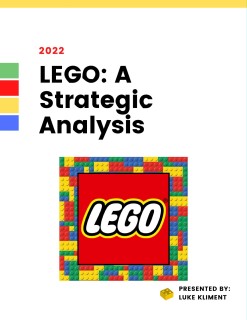
As part of a university assignment, Brickset member Luke Kliment wrote a piece about the LEGO Company and felt it would be of interest to readers here. He writes:
"I am currently a Senior at Indiana University’s Kelley School of Business majoring in Finance and Business Law. For the capstone project in my Strategic Management course, I was tasked with applying class concepts of business strategy to a firm or industry of our choosing – naturally, I chose LEGO.
"In total there were around 20 key topics discussed in the course, but in order to respect the page limit and general outlines provided by our Professor, I only touched on what I felt to be the 4 most prominent, applicable concepts.
"I don't think any of the information included is news to anyone here – and I know the report itself is by no means perfect – but I thought it might be interesting to see it applied in this type of context."
You can download it as a PDF or view images after the break.
110 likes

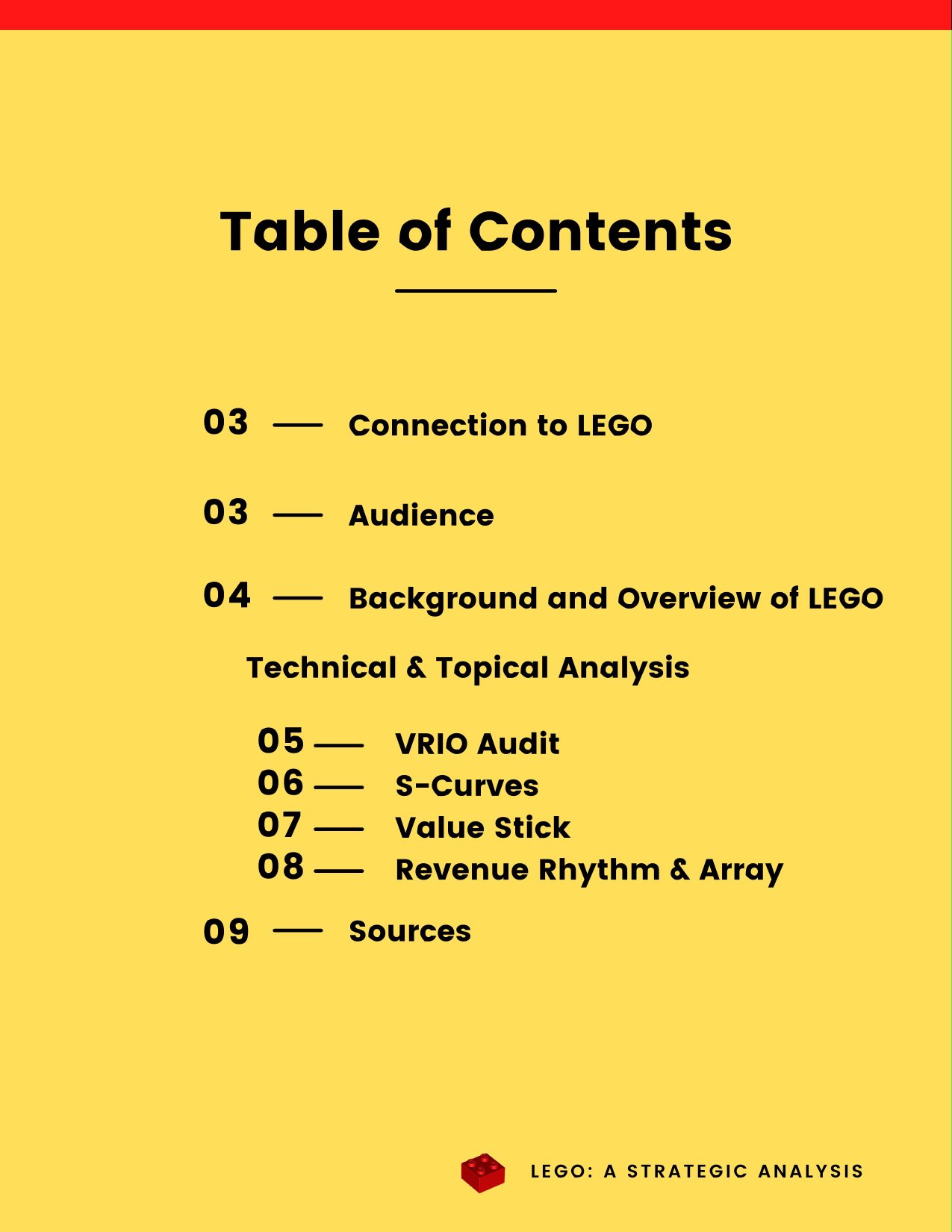
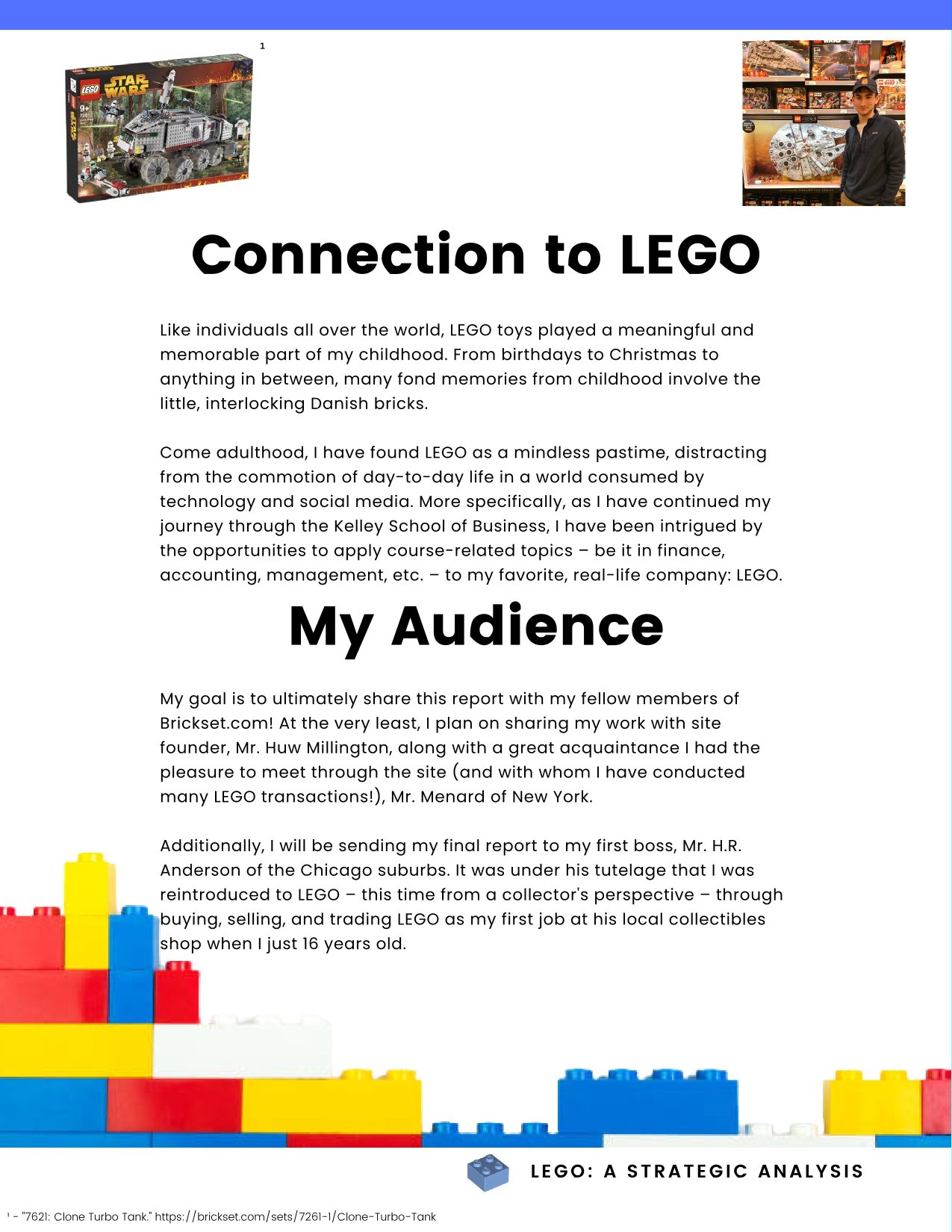
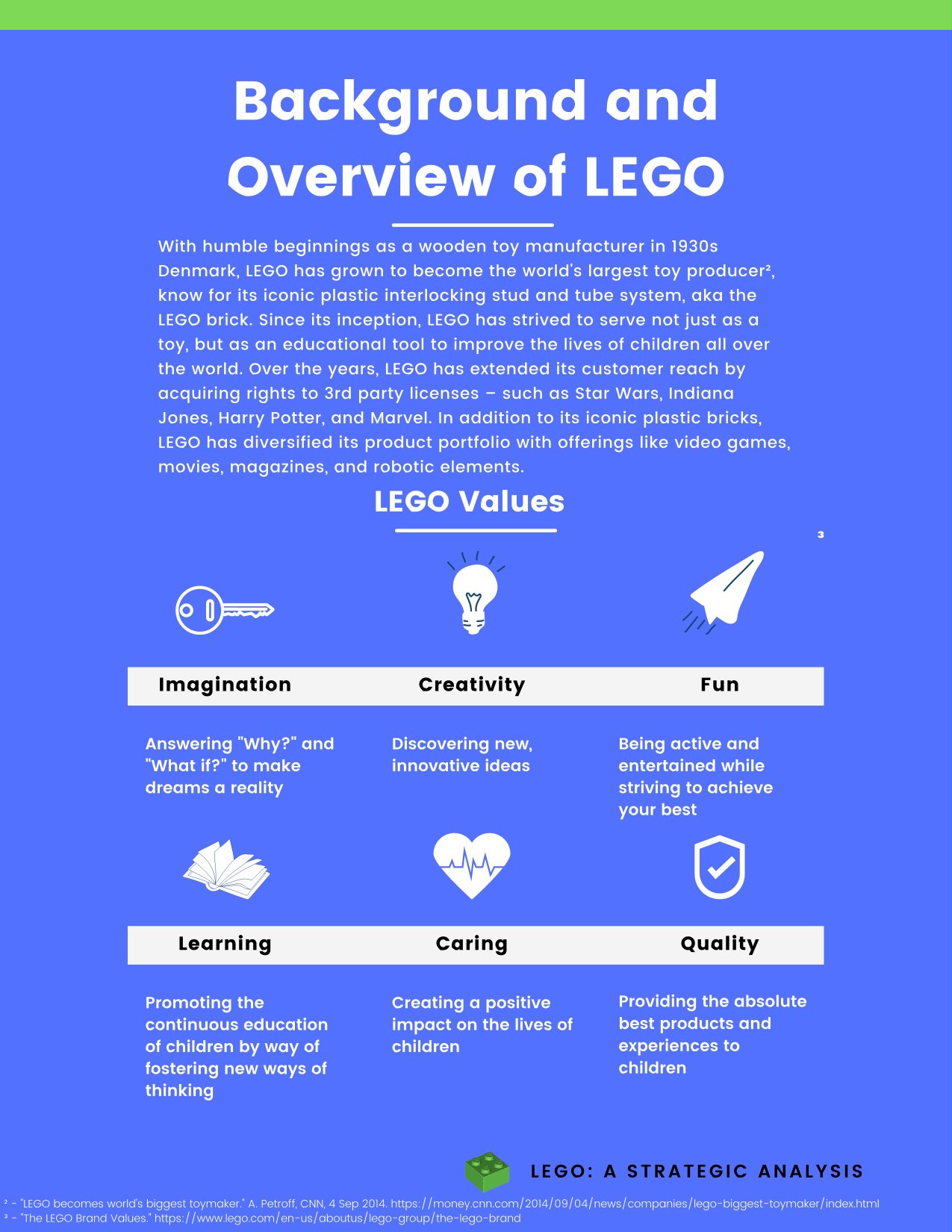
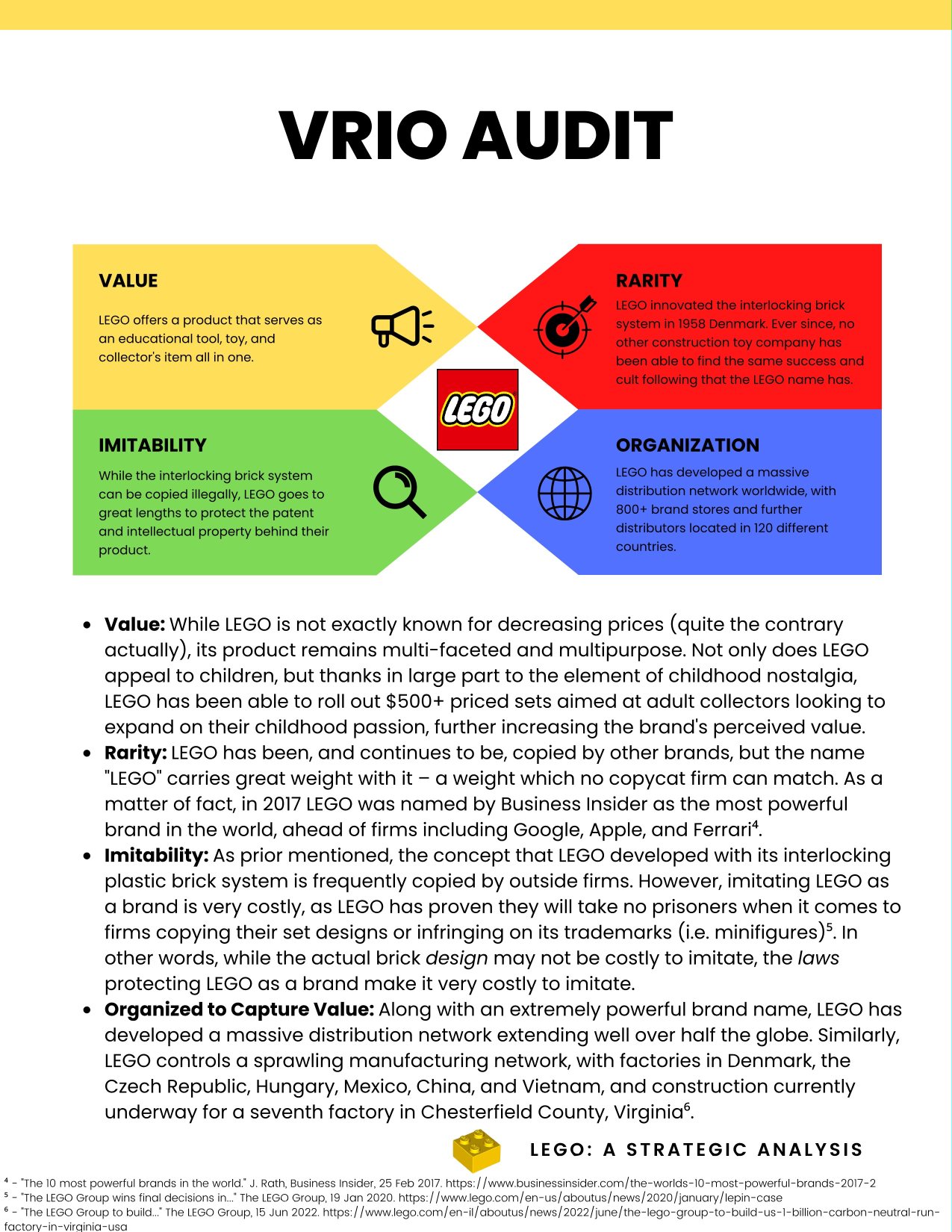
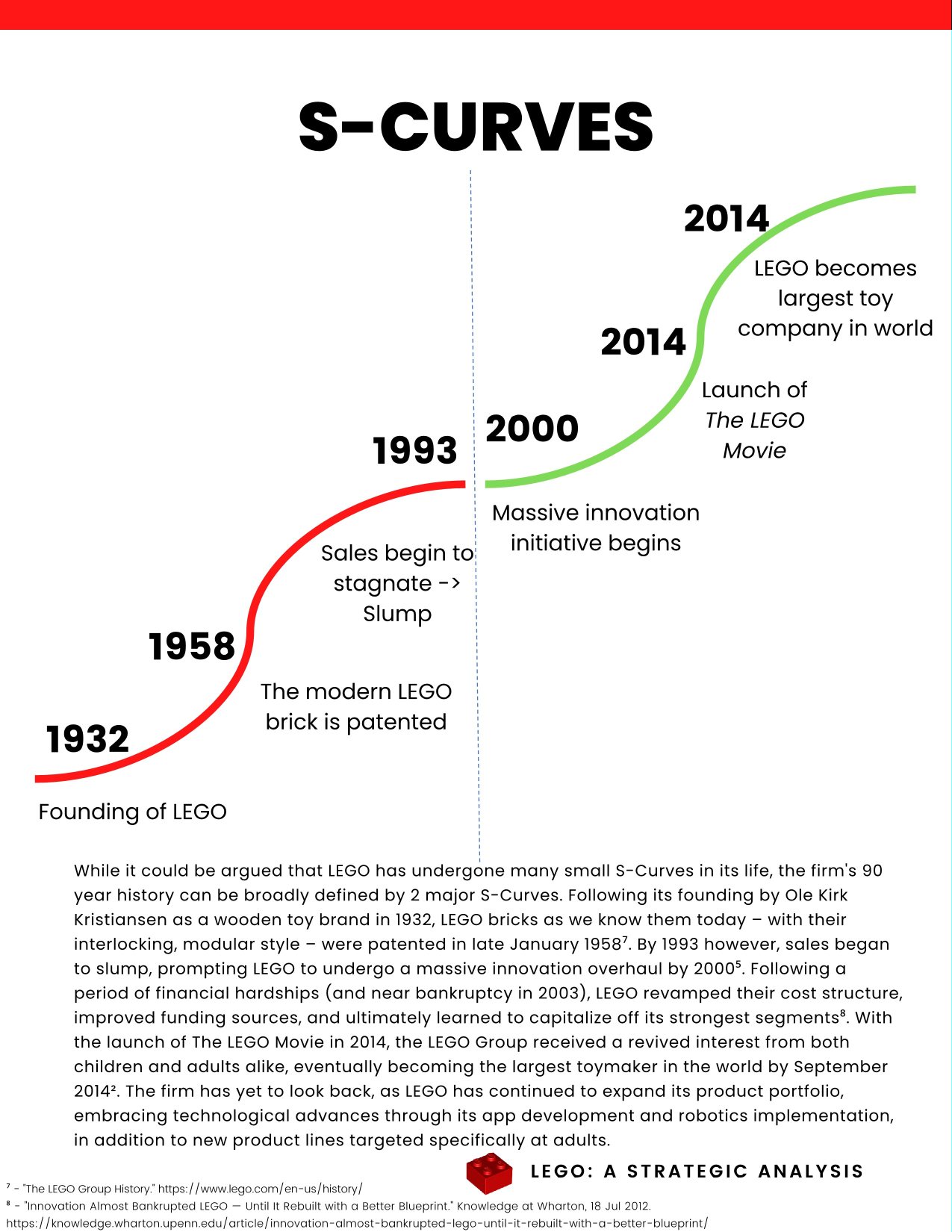
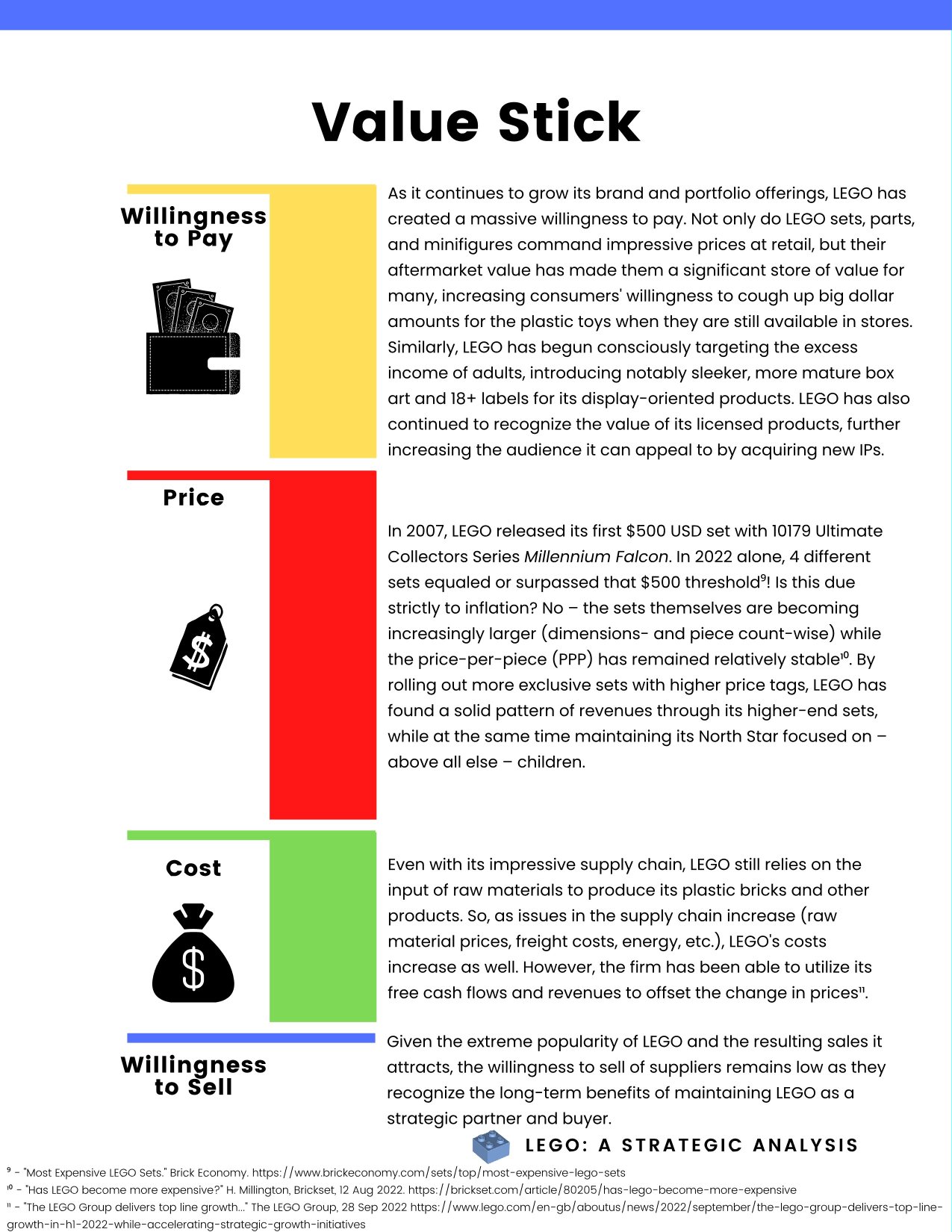
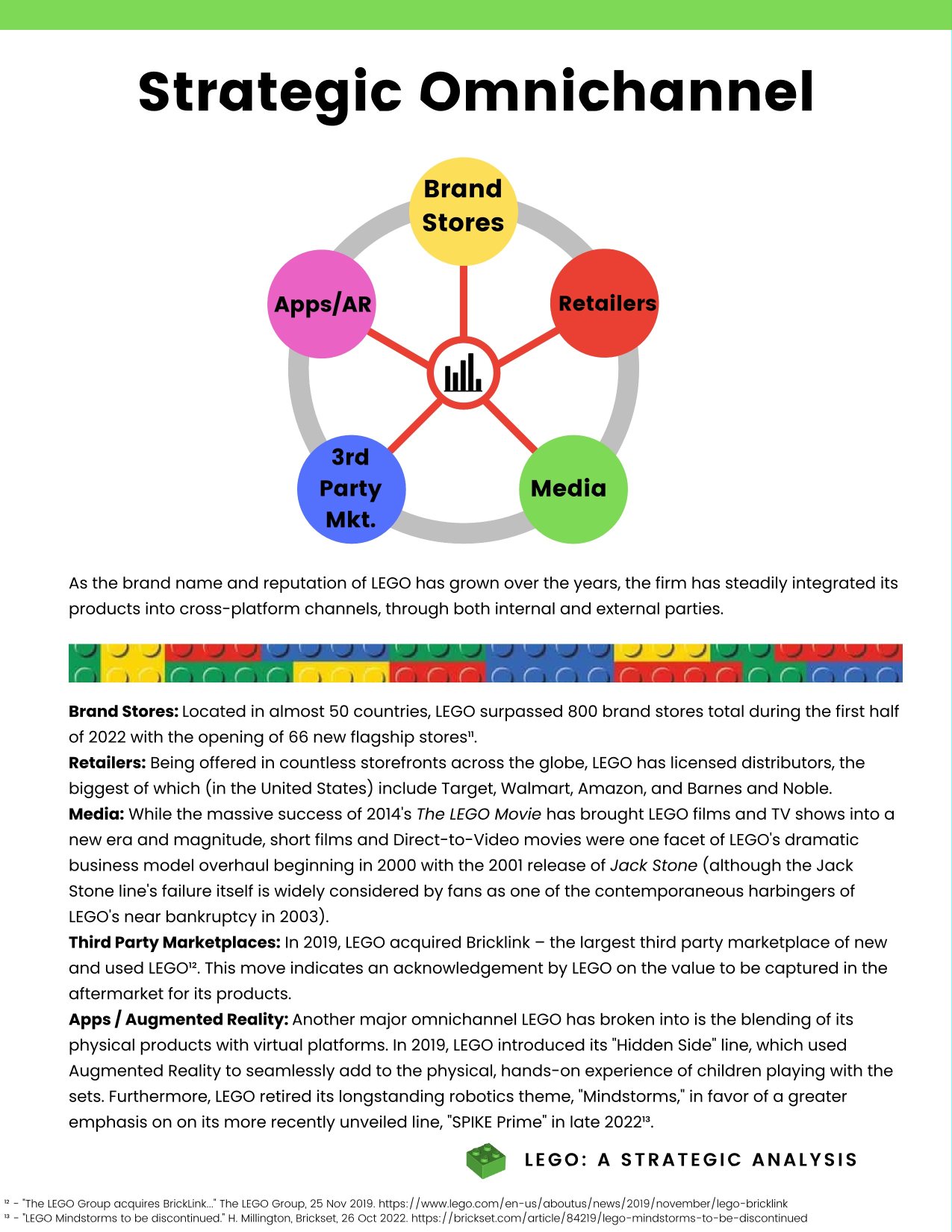
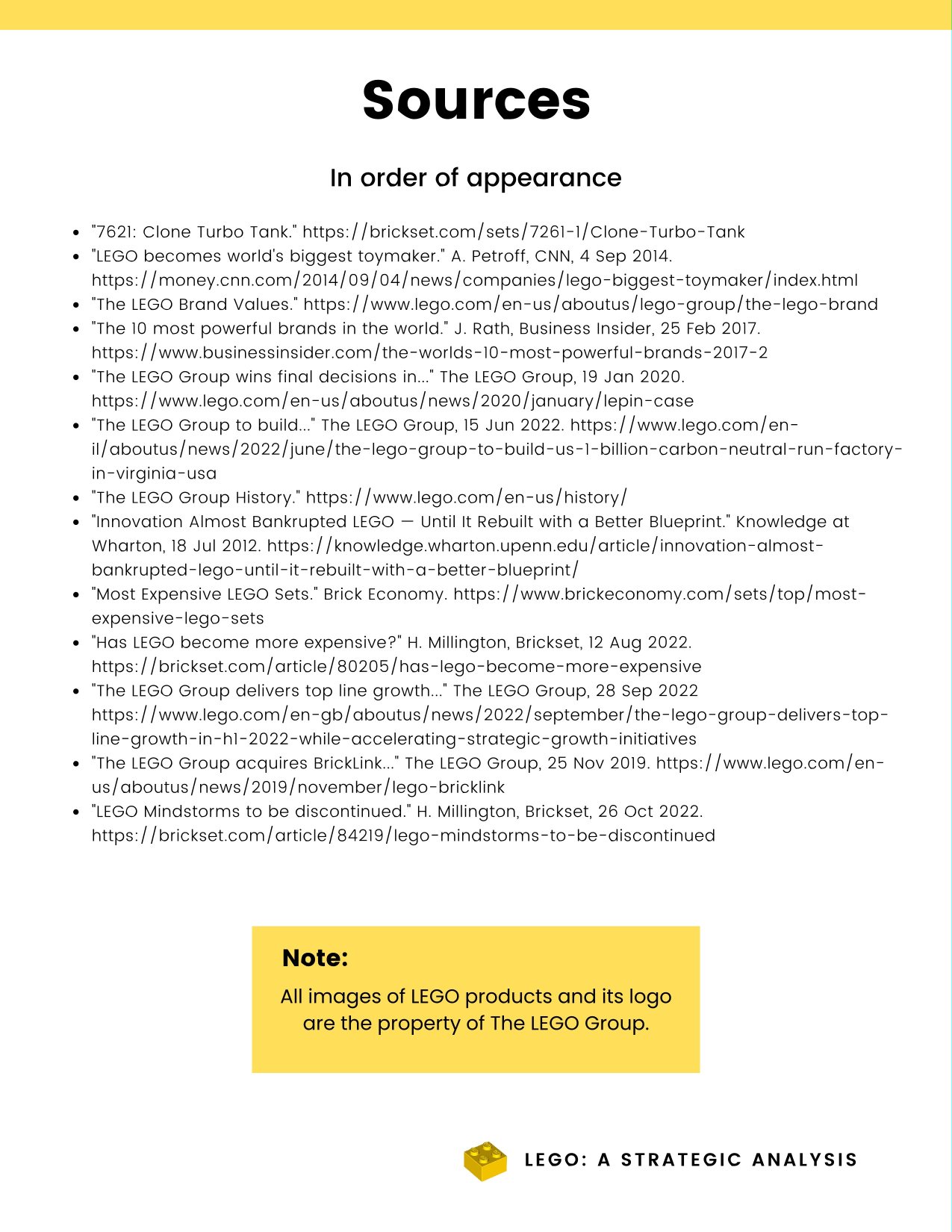
22 comments on this article
If only I can get uni assignments like this! Nice work Luke!
Congratulations, Luke! This is an awesome project. It's great to bring your interests into school work like this and it's cool to read a report like this created by a fellow Brickset member. Good luck with the rest of your degree!
Interesting, good written piece (no new information for me though..).
One thing:
Value Stick - Cost: 'However, the firm has been able to utilize it's free cash flows and revenues to offset the change in prices.' Yes, that and massive layoffs...
Many thanks for sharing this information.
I have issues with the opaque quality of the printing and I'm curious to know why this issue haven't been resolved. Also what I started noticing, and many reviewers pointed this out is that the colour discrepancy between 'identical' bricks. I feel like some area of quality control is being traded for something else. :(
Bravo for the work!
As far as I'm concerned, the willingness to pay has been lost to me mid-2022 with the latest price hike/"alignement".
Not later than yesterday in a Lego store, I just took a single 4 € minifigure from the new series, whereas I would have taken several more if they had still been at 3 €. In september when the price will hike again due to the need to buy figs through resellers, I'm afraid I'll just buy none.
Thank you Luke for sharing this freely with us. It's written and designed really well. All the best in your uni.
An interesting read, looks like a decent uni paper. Certainly presentation quality has moved on a long way since I was at university!
Interesting. Thank you for sharing. Some remarks:
- expected a couple of small matrices (Ansof, BCG, McKinsey, etc.) to posit Lego within its sector/industry (vs Playmobil, Mattel - Megabloks – and show how the competition may be trying to follow Lego). I always think it is great to manage to build your own analysis matrices for a given company based on the key strategic drivers you have identified and that matter to build or maintain the company’s competitive advantage(s).
Recently bumped into ‘Business Model Canvas’ grid analysis, maybe worth a read.
- licence vs non licence
- distinction btw Lego and TLG
- Michael Porter's tools: 5 forces etc. problably a SWOT ('cause people love that)
- still unclear why they open so many retail shops when the ‘market’ seems to move away from that model
- move into ‘adult’ market
- any new business model (crowfunding, patreon, streaming, small ‘curated’ collections, on-demand sets) being successful that Lego could imitate?
Would have been interested in a conclusion based on the above:
which strategic direction you think Lego should take? Because the double S curve (a bit forced but cool) seems to indicate they have reached another end of a cycle.
What should be their next moves: crowfunded sets – partly tested at Bricklink – more/new licences (derived products from successful video games finally), having another close encounter with bankruptcy, more augmented reality after the failures of Vidiyo and Hidden Side, shorter range and more variety, vote for 2 old product re-releases every year, Black-series type of stuff, on-demand toys (be the Netflix of toys), curating new toy collection (season, diversity,) etc. ?
@Tijgeric said:
"Bravo for the work!
As far as I'm concerned, the willingness to pay has been lost to me mid-2022 with the latest price hike/"alignement".
Not later than yesterday in a Lego store, I just took a single 4 € minifigure from the new series, whereas I would have taken several more if they had still been at 3 €. In september when the price will hike again due to the need to buy figs through resellers, I'm afraid I'll just buy none."
Unfortunately the same price hikes can be observed with gas, food, clothing, energy and almost anything imaginable. Inflation is a petasse. But here, I don't have much choice.
@CCC said:
" @MarkingX said:
"Many thanks for sharing this information.
I have issues with the opaque quality of the printing and I'm curious to know why this issue haven't been resolved. Also what I started noticing, and many reviewers pointed this out is that the colour discrepancy between 'identical' bricks. I feel like some area of quality control is being traded for something else. :("
Their motto is now "If it sells it is good enough"."
Yet they say it's "Only the best is good enough". Yeah right.
@thor96 said:
" @Tijgeric said:
"Bravo for the work!
As far as I'm concerned, the willingness to pay has been lost to me mid-2022 with the latest price hike/"alignement".
Not later than yesterday in a Lego store, I just took a single 4 € minifigure from the new series, whereas I would have taken several more if they had still been at 3 €. In september when the price will hike again due to the need to buy figs through resellers, I'm afraid I'll just buy none."
Unfortunately the same price hikes can be observed with gas, food, clothing, energy and almost anything imaginable. Inflation is a petasse. But here, I don't have much choice. "
When these companies that sell hobbies realize that their products aren't a necessity and in the face of rising costs of living their sales will suddenly drop, it will be a humbling experience.
Great summarized article. I found omni-channel interesting as how you distribute becomes ever more important, although I would add 'exclusive' Lego store sets maintain brand and prevent discounting. Only thing missing in your S-curve is the transition from own IP products more towards licensing and franchise agreements with other 3rd parties, presumably as this is what the marketing department says sells.
Nice work, fellow Hoosier. Go Cream & Crimson!
There's something that the S-curves highlight that I never quite understood: if your company stagnates in sales, meaning there's no growth or decline, why is it bad? You get a stable salary and so do the other employees, there's a stable profit going back in the company, and assuming your sales cover all your expenses (R&D, marketing, salaries, etc), why is there a need for extra profits to constantly increase? I mean, I understand that it's a positive thing if it increases, but constant growth isn't sustainable...
@Phoenixio said:
"There's something that the S-curves highlight that I never quite understood: if your company stagnates in sales, meaning there's no growth or decline, why is it bad? You get a stable salary and so do the other employees, there's a stable profit going back in the company, and assuming your sales cover all your expenses (R&D, marketing, salaries, etc), why is there a need for extra profits to constantly increase? I mean, I understand that it's a positive thing if it increases, but constant growth isn't sustainable..."
My understanding of economics and finance is not significantly greater than that of a layperson (I've just taken a few classes in college and watched some YouTube videos), but consistent growth is what investors want because it indicates that their investment was a good choice (so their money isn't wasted). It might seem strange that people anticipate constant growth, and it very well may be impossible in the very long run, but for now consistent innovations in technology mean that most companies can show growth every quarter of the financial year. This isn't necessarily as relevant for Lego since they're privately owned, but it's not entirely irrelevant since they still have to deal with being compared to other publicly held companies.
@ambr said:
"Great summarized article. I found omni-channel interesting as how you distribute becomes ever more important, although I would add 'exclusive' Lego store sets maintain brand and prevent discounting. Only thing missing in your S-curve is the transition from own IP products more towards licensing and franchise agreements with other 3rd parties, presumably as this is what the marketing department says sells."
In my original draft I mentioned the element of exclusive sets, but due to the page restrictions I cut it. I remember the days when sets were marked on their boxes as “Limited Edition” or “Special Edition” – unfortunately it seems those days are gone, more or less. As for the S-curve, I agree! If I had made a third curve (as mentioned, there’s a million you could do for LEGO), I would’ve mentioned the licensed products. For the purposes of this, I just wanted to highlight the current drivers of LEGO’s overall strategy and to me, nearly going bankrupt was a key driver! I hope you enjoyed the paper!
@Meadius said:
" @Phoenixio said:
"There's something that the S-curves highlight that I never quite understood: if your company stagnates in sales, meaning there's no growth or decline, why is it bad? You get a stable salary and so do the other employees, there's a stable profit going back in the company, and assuming your sales cover all your expenses (R&D, marketing, salaries, etc), why is there a need for extra profits to constantly increase? I mean, I understand that it's a positive thing if it increases, but constant growth isn't sustainable..."
My understanding of economics and finance is not significantly greater than that of a layperson (I've just taken a few classes in college and watched some YouTube videos), but consistent growth is what investors want because it indicates that their investment was a good choice (so their money isn't wasted). It might seem strange that people anticipate constant growth, and it very well may be impossible in the very long run, but for now consistent innovations in technology mean that most companies can show growth every quarter of the financial year. This isn't necessarily as relevant for Lego since they're privately owned, but it's not entirely irrelevant since they still have to deal with being compared to other publicly held companies."
At first I was convinced, but then I went deeper: aren't investors paid through the extra profit? So even if it's constant, it would mean constant dividends? I know there are quite a few different ways this can work, but a company being in the positives without grow would still allow for decent revenue for investors.
To me this is linked deeply into brand recognition: I never understand why big companies reach a point where they lay off a ton of people or diminish the quality of their product for instant "growth" in profits. In the end the products were doing great already and you had strong customer support, why lower the quality and go away from your initial values? But maybe I'm not greedy enough to understand the point in the end.
@Phoenixio said:
"There's something that the S-curves highlight that I never quite understood: if your company stagnates in sales, meaning there's no growth or decline, why is it bad? You get a stable salary and so do the other employees, there's a stable profit going back in the company, and assuming your sales cover all your expenses (R&D, marketing, salaries, etc), why is there a need for extra profits to constantly increase? I mean, I understand that it's a positive thing if it increases, but constant growth isn't sustainable..."
A stagnation in sales is definitely not a bad thing (necessarily). “Blue-chip” stocks tend to be considered as such because they are consistent – they can be used to hedge against higher growth, riskier stocks. In other words, they’re growth has matured. Due to the parameters of the assignment I couldn’t really elaborate more, but the S-curves in this case are more so aimed at what impacted LEGO’s strategy. I hope you enjoyed the paper!
First off, thank you to @Huw for providing me with this opportunity to share! Thank you to @SumoLego for his support and feedback as well! And thank you to you all for the positive comments and support! As I mentioned, I know none of it is really news, but I thought you might like seeing it anyways. Thank you again to everyone!
@jeandesirekatanga said:
"Interesting. Thank you for sharing. Some remarks:"
I appreciate the feedback! The fundamental reason for the exclusion of just about all of this info was the simple fact that there were page limits and certain parameters put forth in the rubric that I had to adhere to. Ultimately this was for a significant grade so I had to keep that in mind above all else! Competitor analysis, Advanced Business Model Canvas, etc. were other topics from the course, but like I said I decided to go with what I felt would be the most pertinent. My original draft did have a brief conclusion, but the limit of ~8 pages made it expendable. I hope you enjoyed the paper!
@LegoBoi69 said:
"How to take the fun out of Lego ^^^"
For me, LEGO is what made the assignment fun ¯\_(?)_/¯
@jeandesirekatanga said:
"
- still unclear why they open so many retail shops when the ‘market’ seems to move away from that model
"
LEGO doesn’t regard physical stores as a sales channel. It’s a marketing channel as far as LEGO is concerned where the company can showcase ‘the LEGO experience’. That’s why recent stores have mostly been opened in the most conspicuous locations (high visibility/footfall/tourist areas) rather than shopping destinations (out-of-town shopping centres/suburban locations). Sure, you can buy products at LEGO stores (as I did earlier this week!) but their primary purpose is to raise brand awareness and mindshare.